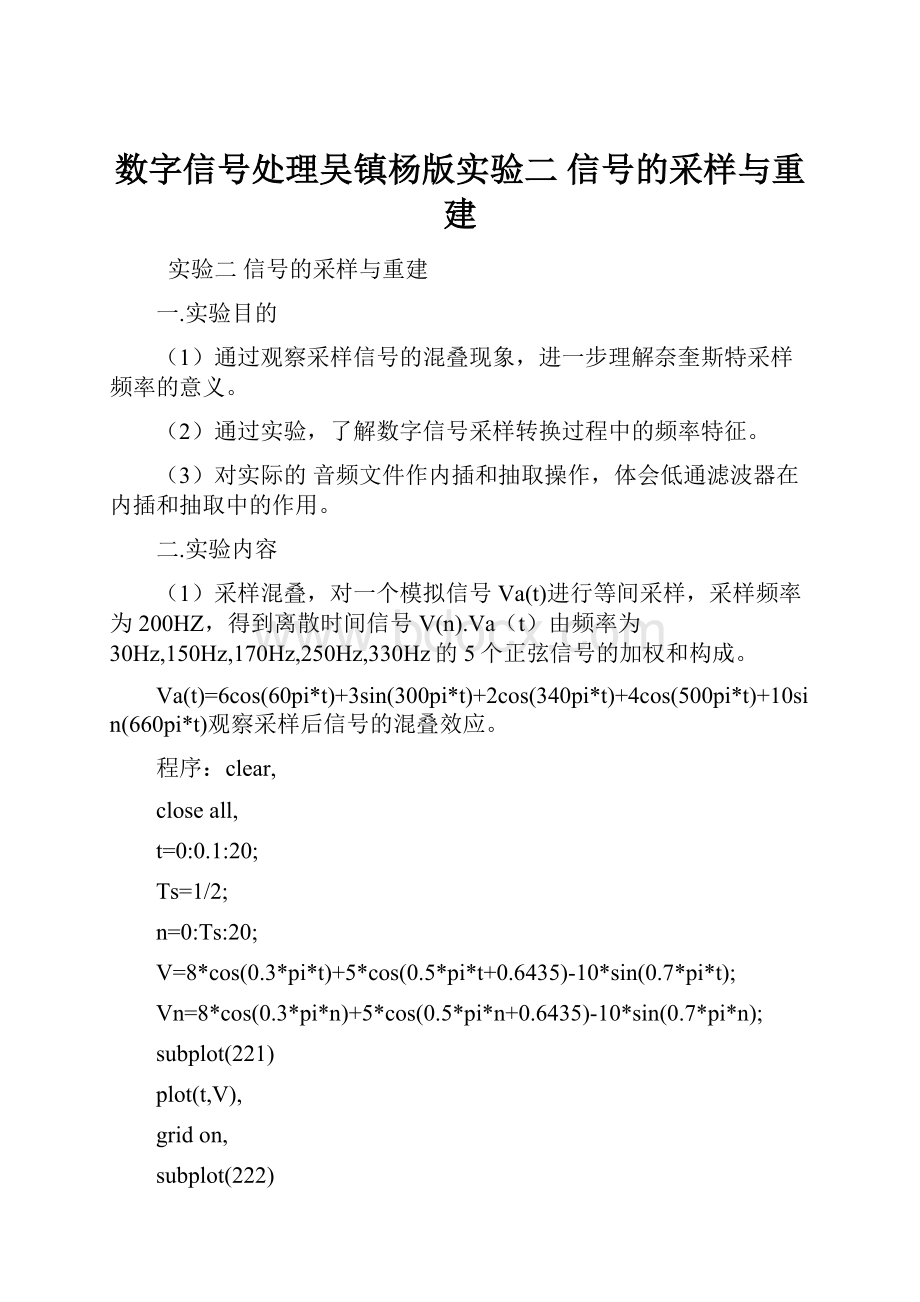数字信号处理吴镇杨版实验二 信号的采样与重建.docx
《数字信号处理吴镇杨版实验二 信号的采样与重建.docx》由会员分享,可在线阅读,更多相关《数字信号处理吴镇杨版实验二 信号的采样与重建.docx(23页珍藏版)》请在冰豆网上搜索。

数字信号处理吴镇杨版实验二信号的采样与重建
实验二信号的采样与重建
一.实验目的
(1)通过观察采样信号的混叠现象,进一步理解奈奎斯特采样频率的意义。
(2)通过实验,了解数字信号采样转换过程中的频率特征。
(3)对实际的音频文件作内插和抽取操作,体会低通滤波器在内插和抽取中的作用。
二.实验内容
(1)采样混叠,对一个模拟信号Va(t)进行等间采样,采样频率为200HZ,得到离散时间信号V(n).Va(t)由频率为30Hz,150Hz,170Hz,250Hz,330Hz的5个正弦信号的加权和构成。
Va(t)=6cos(60pi*t)+3sin(300pi*t)+2cos(340pi*t)+4cos(500pi*t)+10sin(660pi*t)观察采样后信号的混叠效应。
程序:
clear,
closeall,
t=0:
0.1:
20;
Ts=1/2;
n=0:
Ts:
20;
V=8*cos(0.3*pi*t)+5*cos(0.5*pi*t+0.6435)-10*sin(0.7*pi*t);
Vn=8*cos(0.3*pi*n)+5*cos(0.5*pi*n+0.6435)-10*sin(0.7*pi*n);
subplot(221)
plot(t,V),
gridon,
subplot(222)
stem(n,Vn,'.'),
gridon,
(2)输入信号X(n)为归一化频率f1=0.043,f2=0.31的两个正弦信号相加而成,N=100,按因子M=2作抽取:
(1)不适用低通滤波器;
(2)使用低通滤波器。
分别显示输入输出序列在时域和频域中的特性。
程序:
clear;
N=100;
M=2;
f1=0.043;
f2=0.31;
n=0:
N-1;
x=sin(2*pi*f1*n)+sin(2*pi*f2*n);
y1=x(1:
2:
100);
y2=decimate(x,M,'fir');
figure
(1);
stem(n,x(1:
N));
title('inputsequence');
xlabel('n');ylabel('fudu');
figure
(2);
n=0:
N/2-1;
stem(n,y1);
title('outputsequencewithoutLP');
xlabel('n');ylabel('fudu');
figure(3);
m=0:
N/M-1;
stem(m,y2(1:
N/M));
title('outputsequencewithLP');
xlabel('n');ylabel('fudu');
figure(4);
[h,w]=freqz(x);
plot(w(1:
512),abs(h(1:
512)));
title('frequencyspectrumoftheinputsequence');
xlabel('w');ylabel('fudu');
figure(5);
[h,w]=freqz(y1);
plot(w(1:
512),abs(h(1:
512)));
title('frequencyspectrumoftheoutputsequencewithoutLP');
xlabel('w');ylabel('fudu');
figure(6);
[h,w]=freqz(y2);
plot(w(1:
512),abs(h(1:
512)));
title('frequencyspectrumoftheoutputsequencewithoutLP');
xlabel('w');ylabel('fudu');
(3)输入信号X(n)为归一化频率f1=0.043,f2=0.31的两个正弦信号相加而成,长度N=50,内插因子为2.
(1)不适用低通滤波器;
(2)使用低通滤波器。
分别显示输入输出序列在时域和频域中的特性。
程序:
clear,
closeall,
N=50;
L=2;
f1=0.043;
f2=0.31;
n=0:
N-1;
x=sin(2*pi*f1*n)+sin(2*pi*f2*n);
figure
(1);
stem(n,x(1:
N));
title('inputsequence');
xlabel('n');ylabel('fudu');
y1=zeros(1,N*2);
y1(1:
2:
N*2)=x;
figure
(2);
m=0:
N*L-1;
stem(m,y1(1:
N*L));
title('outputsequence');
xlabel('n');ylabel('fudu');
y2=interp(x,L);
figure(3);
m=0:
N*L-1;
stem(m,y2(1:
N*L));
title('outputsequence');
xlabel('n');ylabel('fudu');
figure(4);
[h,w]=freqz(x);
plot(w(1:
512),abs(h(1:
512)));
title('frequencyspectrumoftheinputsequence');
xlabel('w');ylabel('fudu');
figure(5);
[h,w]=freqz(y1);
plot(w(1:
512),abs(h(1:
512)));
title('frequencyspectrumoftheoutputsequence');
xlabel('w');ylabel('fudu');
figure(6);
[h,w]=freqz(y2);
plot(w(1:
512),abs(h(1:
512)));
title('frequencyspectrumoftheoutputsequence');
xlabel('w');ylabel('fudu');
二.(3)令x(n)=cos(2*pi*f*n/fs),其中f/fs=1/16,即每个周期内有16个点。
试用MATLAB编程实现:
1).作M=4倍的抽取,使每个周期变成4点。
程序:
clear,
closeall,
N=100;
M=4;
n=0:
N-1;
x=cos(2*pi*n*(1/16));
stem(n,x(1:
N));
title('inputsequence');
xlabel('n');ylabel('fudu');
y1=x(1:
4:
100);
y2=decimate(x,M,'fir');
figure
(2);
m=0:
N/4-1;
stem(m,y1);
title('outputsequence');
xlabel('n');ylabel('fudu');
figure(3);
m=0:
N/M-1;
stem(m,y2(1:
N/M));
title('outputsequence');
xlabel('n');ylabel('fudu');
figure(4);
[h,w]=freqz(x);
plot(w(1:
512),abs(h(1:
512)));
title('frequencyspectrumoftheinputsequence');
xlabel('w');ylabel('fudu');
figure(5);
[h,w]=freqz(y1);
plot(w(1:
512),abs(h(1:
512)));
title('frequencyspectrumoftheoutputsequence');
xlabel('w');ylabel('fudu');
figure(6);
[h,w]=freqz(y2);
plot(w(1:
512),abs(h(1:
512)));
title('frequencyspectrumoftheoutputsequence');
xlabel('w');ylabel('fudu');
2).作L=3倍的插值,使每个周期变成48点。
程序:
clear,
closeall,
N=50;
L=3;
n=0:
N-1;
x=cos(2*pi*n*(1/16));
figure
(1);
stem(n,x(1:
N));
title('inputsequence');
xlabel('n');ylabel('fudu');
y1=zeros(1,N*3);
y1(1:
3:
N*3)=x;
figure
(2);
m=0:
N*3-1;
stem(m,y1(1:
N*3));
title('outputsequence');
xlabel('n');ylabel('fudu');
y2=interp(x,L);
figure(3);
m=0:
5:
N*L-1;
stem(m,y2(1:
5:
N*L));
title('outputsequence');
xlabel('n');ylabel('fudu');
figure(4);
[h,w]=freqz(x);
plot(w(1:
512),abs(h(1:
512)));
title('frequencyspectrumoftheinputsequence');
xlabel('w');ylabel('fudu');
figure(5);
[h,w]=freqz(y1);
plot(w(1:
512),abs(h(1:
512)));
title('frequencyspectrumoftheoutputsequence');
xlabel('w');ylabel('fudu');
figure(6);
[h,w]=freqz(y2);
plot(w(1:
64),abs(h(1:
64)));
title('frequencyspectrumoftheoutputsequence');
xlabel('w');ylabel('fudu');
(4).输入信号x(n)为归一化频率分别是f1=0.04,f2=0.3的正弦信号相加而成,N=50,内插因子为5,抽取因子为3,给出按有理因子5/3做采样率转换的输入输出波形。
程序:
clear,
closeall,
N=50;
M=3;
L=5;
f1=0.04;
f2=0.3;
n=0:
N-1;
x=sin(2*pi*f1*n)+sin(2*pi*f2*n);
y=resample(x,L,M);
figure
(1);
stem(n,x(1:
N));
title('inputsequence');
xlabel('n');ylabel('fudu');
figure
(2);
m=0:
N-1;
stem(m,y(1:
N));
title('outputsequence');
xlabel('n');ylabel('fudu');
figure(3);
[h,w]=freqz(x);
plot(w(1:
512),abs(h(1:
512)));
title('frequencyspectrumoftheinputsequence');
xlabel('w');ylabel('fudu');
figure(4);
[h,w]=freqz(y);
plot(w(1:
512),abs(h(1:
512)));
title('frequencyspectrumoftheoutputsequence');
xlabel('w');ylabel('fudu');